Live Commerce Statistics By Sales, Revenue And Trend (2025)
Updated · Jul 02, 2025

Table of Contents
Introduction
Live Commerce Statistics: Live commerce is going global with intensity now! This trend is the perfect confluence of entertainment, social media, and e-commerce amalgamated into one. By 2024, live commerce had grown in size and had higher conversion rates, higher order values, and better engagement from live commerce interaction compared to traditional ones.
This article will describe the Live Commerce statistics and trends reshaping retail through live interaction.
Editor’s Choice
- Asia heads the global live commerce market, almost touching US$370 billion in 2024, with China alone contributing US$350 billion in beauty, fashion, food, and electronics.
- In 2024, the Americas had about US$27 billion in live commerce revenue, with the U.S. accounting for nearly US$17 billion, followed by Brazil and Mexico.
- China is highest in potential food penetration at 30% and electronics at 15% penetration; South Korea and India were around the 4.5%-10% range, quite similar to the Americas.
- China’s live streaming e-commerce market grew over 40% in the last year.
- Europe’s major countries saw market penetrations in the 3% to 10% bracket; in the United Kingdom, around 10% of consumers are involved in fashion-related live shopping.
- Among other significant players, you have Amazon Live at 30%, company sites and apps at 28%, Twitter, Snapchat at 26%, Twitch at 24%, TikTok at 22%, and Pinterest TV at 14%.
- In 2023, mobile e-commerce generated a revenue of US$2.2 trillion, constituting 60% of all e-commerce sales worldwide; it is expected to grow to US$3.4 trillion and grab a 62% share by 2027.
- Age groups 25-34 years are the most potent contributors to live commerce sales both in China (30%) and the U.S. (28%).
- Livestream commerce is expected to see a worldwide growth of 24% annually, from US$1 trillion in 2024 to US$3.7 trillion by 2030.
- China is predicted to continue to dominate with a US$2.4 trillion market in 2030, growing at a rate of 20% annually.
- The U.S. is forecast to keep growing much faster, increasing at a rate of 47% annually to US$680 billion by 2030.
- Chinese users spend from US$82 to US$90 for the same show and are said to make higher purchases due to engagement. The viewing time of a show averages 36 minutes for China, 31 minutes for the U.S. and Europe, and 41 minutes for Latin America.
General Statistics
- Unlike traditional TV-shopping channels, live commerce is a fully digital experience in which buyers can provide immediate feedback and purchase on the spot.
- Currently, China is the leading country in live commerce globally, with this market amounting to nearly ¥5 trillion in 2023—a 12-fold increase compared to pre-COVID-19 levels.
- The blending of entertainment and shopping during the lockdowns pushed the popularity of live commerce further in China.
- Continuing into 2024, these live shopping trends are also being strongly adopted in other Asia-Pacific countries, including Indonesia, Thailand, and India.
- With some 49 million users foreseen in 2025 and over 60 million by 2028, the live commerce market is expanding quickly in the U.S.
- Brazil is the most active country for live shopping in Latin America, whereas Europe appears to be slower in adoption and is mostly centred on fashion.
- Live commerce happens on a wide variety of platforms; these include specialised live shopping sites, brand sites, and social media, primarily.
- Social media is becoming the primary platform for live commerce activities because of its ease of use and wide reach.
- In the U.S., the best platforms for live shopping in 2024, according to most sources, will be Facebook, TikTok, and Douyin.
- Being first in Southeast Asia for live commerce viewing, TikTok is succeeded by Shopee and Facebook.
Live E-commerce Revenue By Continent
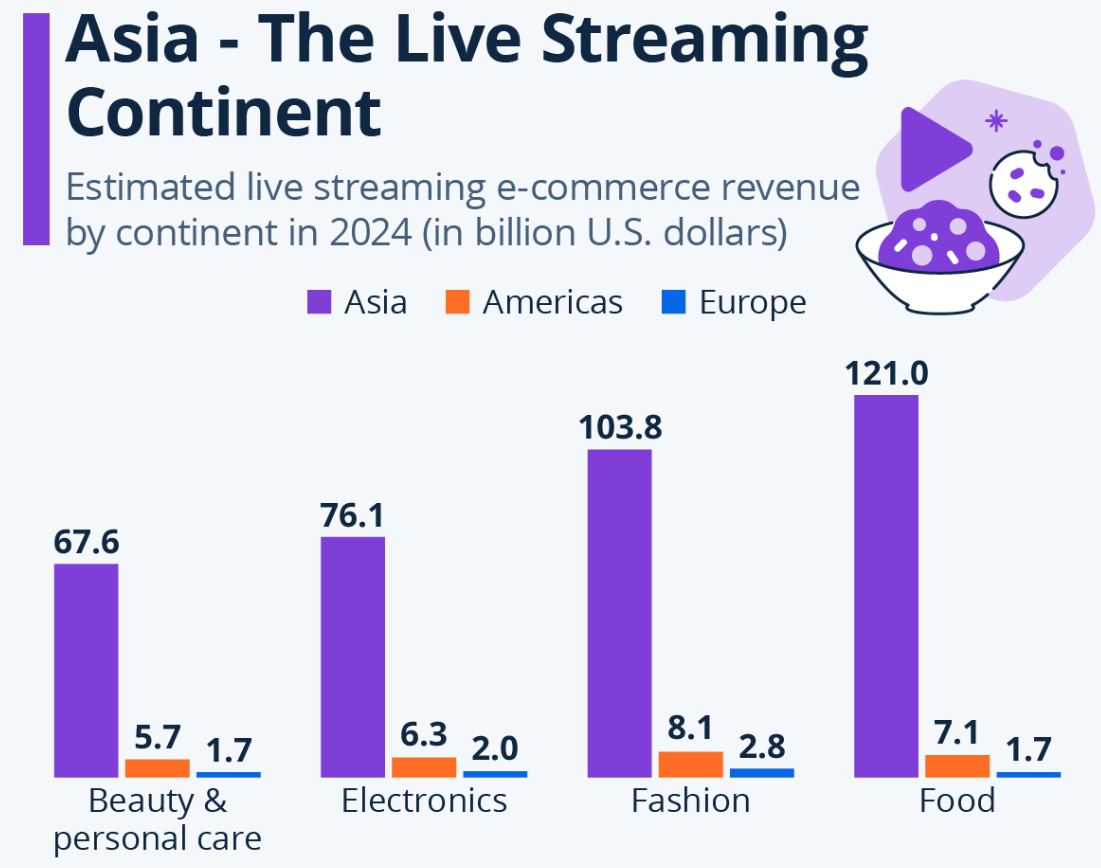
(Source: statista.com)
- As per Statista Report, Live Commerce statistics show that Asia is the prime viable market for live stream e-commerce with a revenue of US$350 billion in 2024 in beauty, fashion, food, and electronics, to mention a few.
- Total revenue in the region across Asia soared close to US$370 billion, according to Statista Market Insights.
- The Americas may have seen approximately US$27 billion in live commerce revenue in 2024, with the United States at the forefront with just under US$17 billion, followed by Brazil and Mexico.
- The United Kingdom, in terms of live commerce activity, was the major player in Europe, whereas some market penetration in some sectors, such as food, would reach up to 30% and electronics approximately 15% in China.
- In contrast, China’s top category was food, bolstered by the development of grocery delivery, alongside innovative concepts such as group buying and direct-from-producer sales through live streaming.
- Big players in China’s live commerce ecosystem are Douyin (the Chinese TikTok), Kuaishou, and Taobao Live from Alibaba. Kuaishou particularly stands out for its food-related live commerce activities as well as for being the more popular option for third-tier cities downwards.
- China’s live e-commerce streaming market posted an expansion of over 40% in the last year.
- Penetration rates in Europe show a range between 3% and 10% across major economies.
- The UK, then, with roughly 10% of consumers engaged in the fashion-related live shopping in 2024, becomes the leading market on the continent for this segment.
Live Commerce Platforms
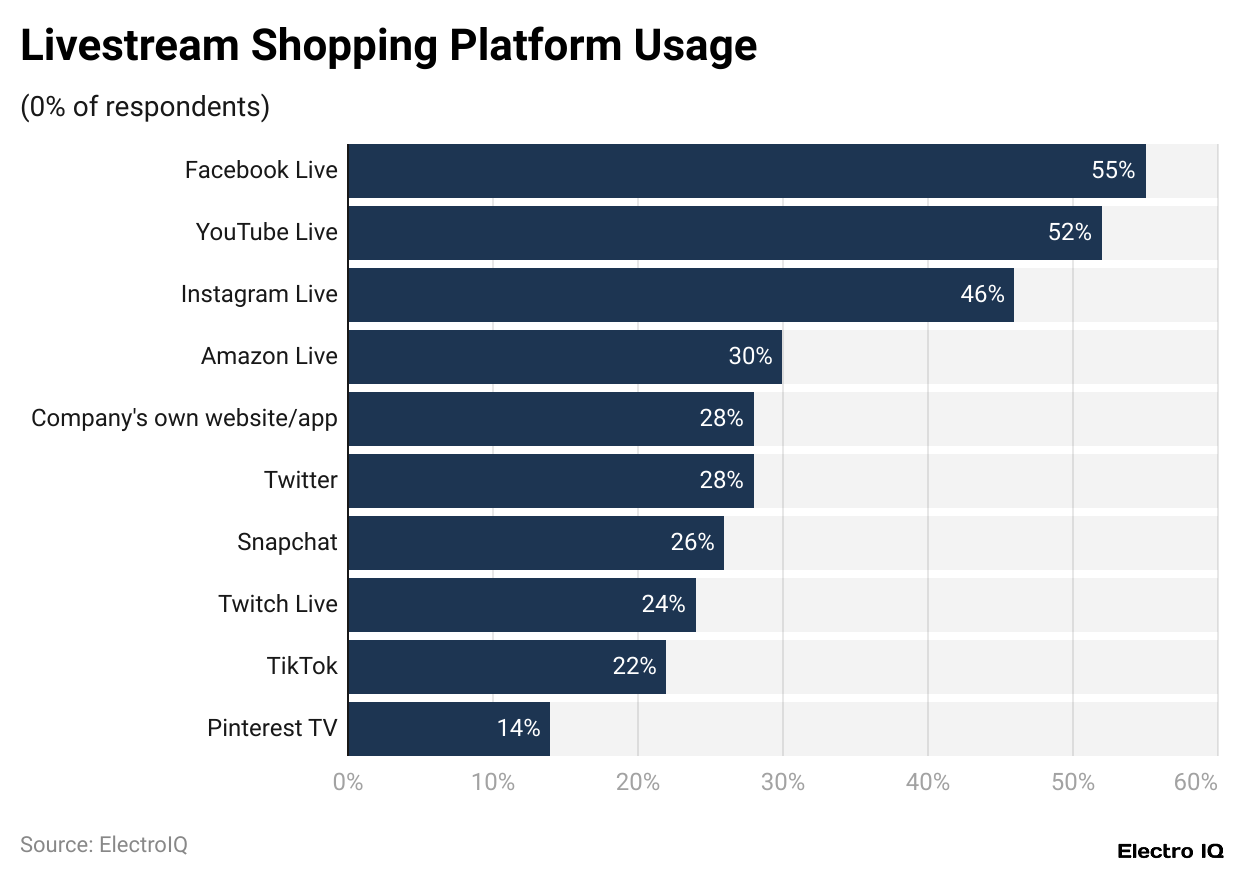
(Reference: fitsmallbusiness.com)
- According to Fitsmallbusiness, Live Commerce statistics reveal that the top social media channel for live commerce is Facebook Live, with 55% of businesses or sellers using it to host live shopping events.
- YouTube, with 52% usage, boasts a robust video infrastructure and a vast audience reach.
- Instagram Live comes third at 46%, revealing its profound presence among brands that appeal to younger, mobile-oriented customers.
- Amazon Live is adopted by 30% of sellers, building on Amazon’s in-built shopping experience to prompt purchases during the livestream. Company-owned websites or apps contribute 28% of live commerce, indicating that plenty of brands want to take the experience into their hands.
- From 28% to 26% of usage, Twitter and Snapchat show a real-time engagement and quick content formats which appeal to some demographics.
- The storied gaming stage of Twitch Live has an appeal for 24% of live sellers as they cater to niche or enthusiast products.
- TikTok, although among the fastest-growing social apps, draws 22% live commerce use, perhaps because of its live shopping features.
- With a utilisation rate of 14%, Pinterest TV, a new kid on the block, would suggest a budding interest in the platform, which, by the way, is also still gaining traction.
Mobile E-commerce Sales
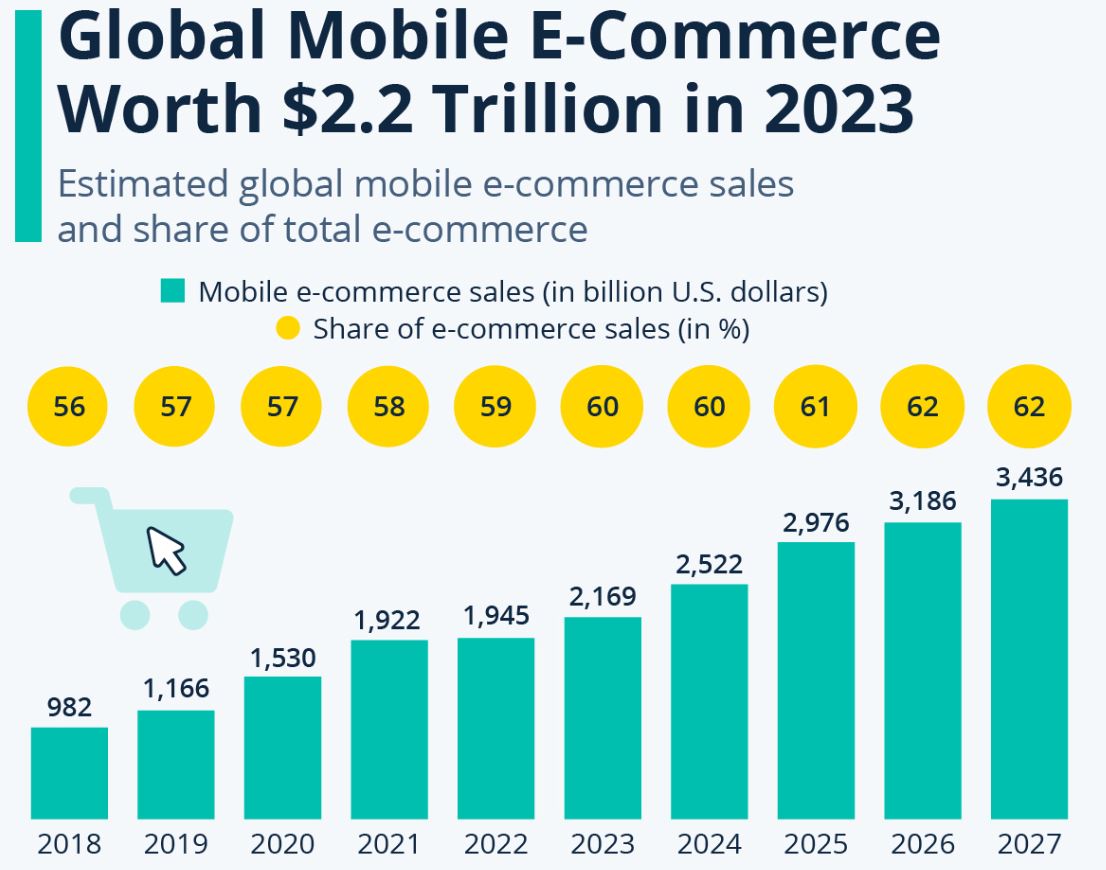
(Source: statista.com)
- Globally, mobile e-commerce acts as one of the main channels propelled by shopping with mobile devices.
- With the mobile sales hitting US$2.2 trillion in 2023, mobile-commerce transactions account for 60% of all e-commerce worldwide. This is a huge twist against consumers’ shopping style.
- Consumers now prefer mobile platforms for the convenience and accessibility provided to them.
- The share of mobile commerce has been steadily increasing at 56% back in 2018, with an expected set to hit around 62% in 2027. The value in sales showed a much more drastic change.
- Mobile commerce gave a global estimate of US$982 billion back in 2018; on the other hand, it is projected to hit US$3.4 trillion by 2027. Such growth is a reflection of increased smartphone penetration and shifting consumer behaviour in favour of mobile-first shopping experiences.
- Mobile commerce will have a bright future everywhere, and this is due to people spending much time on smartphones and tablets, enjoying the liberty of shopping anytime, anywhere, from the commute to work, from work hours to machinery repair, or even from relaxation at home.
Live Commerce Sale By Age Breakdown
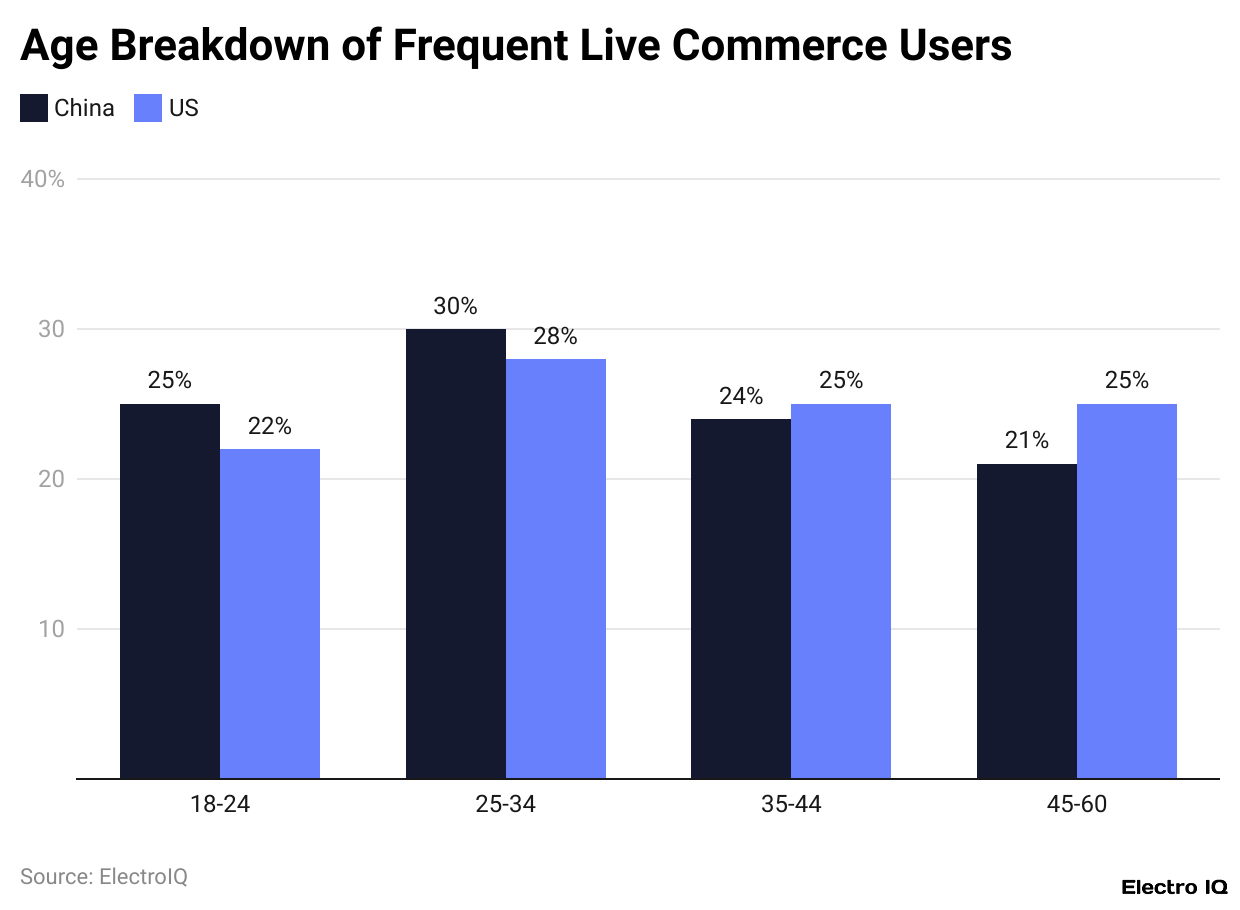
(Reference: arkinvest.com)
- According to Ark. invest, Live Commerce statistics indicate that in China, those most responsible for live-commerce sales are between 25 and 34 years old, accounting for 30% of all purchases.
- Behind these are groups 18 to 24 at 25%, which is mobile commerce sales among younger adults. Next come the 35-to-44 group, with 24%, and the 45-and-above group, with 21%, showing gradually declining participation with age increase.
- In the United States, the 25-34 age group makes up 28% of live-commerce sales, while the 45-60 age group makes up 25%, implying that younger and older middle-aged customers participate equally in live-commerce.
- There is 25% also from the 35-44 age group, with the least representation from 18-24 at 22%.
- China reports contrasting representation among the various age brackets; the United States seems to display a fairly even distribution, favouring the elderly population.
Live Commerce Sale By Country
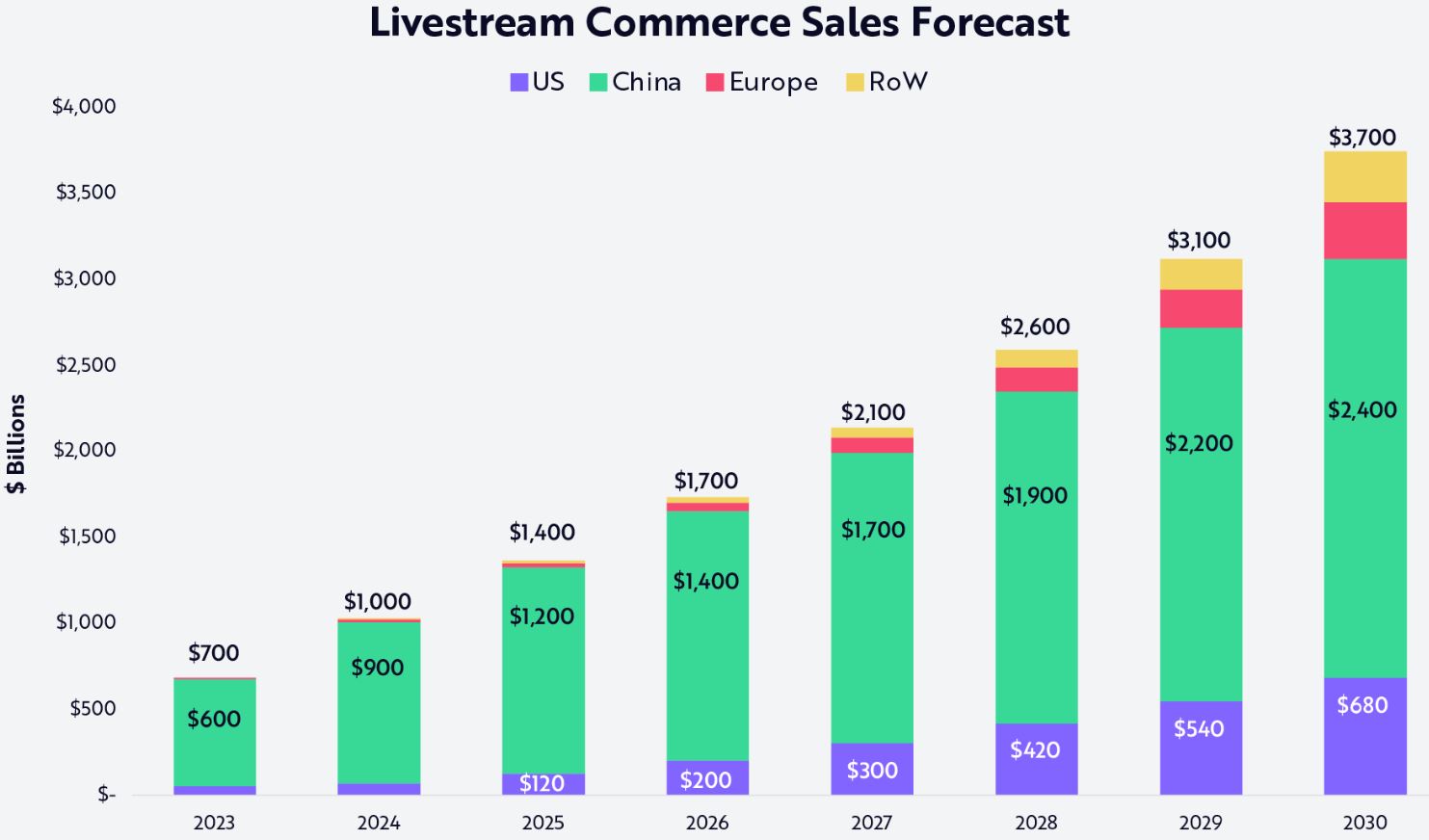
(Source: arkinvest.com)
- Understanding livestream commerce, therefore, is more important than ever. It has been changing brilliantly the way a consumer interacts with a brand online and purchases from it.
- According to recent research, Live Commerce statistics state that the industry is projected to grow at a blistering pace, at almost 24% for the next five years.
- Sitting at an estimated size of US$1 trillion globally today, the market is expected to swell to approximately US$3.7 trillion by 2030.
- The rapid growth, thus, spells out the tortuous change in consumer behaviour with mobile convenience and the role of digital content creation and influencers.
- China is expected to continue its leadership in this sphere, with an estimated 20% annual growth in its livestream commerce market to reach US$2.4 trillion by 2030.
- Other major reasons that make China much further ahead of the global curve for adoption are the early adoption of livestreaming, deep integration into mainstream e-commerce platforms, and the massive pool of digital users.
- Meanwhile, the United States is also becoming a strong contender within this space. The United States started later in adopting livestream commerce than China; however, the U.S. market is expected to post a much higher 47% CAGR.
- Livestream sales could touch up to US$680 billion in the U.S. by 2030, riding on the back of digital infrastructure, social commerce platform usages, and interests from retail and influencers.
- This global movement marks another dawn for digital retail: real-time engagement and entertainment take precedence alongside quality and price.
- Livestream shopping feeds into an immersive and interactive commerce experience for both brands and consumers.
Live Commerce Spending By Country

(Source: mckinsey.com)
- In China, frequent live-commerce viewers watched extensively more shows during the past year than their U.S., European, and Latin American counterparts.
- While Chinese viewers, on average, were shown to spend less per live show-watching instance (US$82-US$90), as against US$127-US$197 by some other regions
- The regional volume of purchases made by Chinese viewers outweighed the deficit in spending per show, thanks to the viewers’ much larger volume.
- In this context, the average dollars per transaction were smaller, whereas overall spending was huge. Engagement-wise, the average viewing time for each live commerce session remained fairly consistent across the regions.
- Users from the United States and Europe viewed any session for about 31 minutes, while users from China viewed it for 36 minutes.
- In contrast, viewers in Latin America viewed these shows for the longest average time of 41 minutes.
Conclusion
Live Commerce Statistics: The era of live commerce being a fleeting trend is over; it is today a multi-billion-dollar industry, reshaping patterns of consumer behaviour and retail avenues. From Asia’s dominance on platforms like Taobao and regional innovation coming out of the United States, to beyond, this has been a paradigm shift in how we conduct shopping.
In light of ongoing development in AR, AI, sustainability, and global expansion, live commerce is on its way to becoming the top retail force in the future.
FAQ.
China leads the global live commerce market, with an income of approximately US$350 billion in 2024. This accounts for the majority of Asia US$370 billion in the live commerce revenue total. China’s emergence on the scene was through the almost universal adoption of its platforms in the domestic market, coupled with very high usage (Douyin, Kuaishou, Taobao Live) and innovations in grocery delivery and direct-to-producer sales.
The global live commerce market is growing at a rate of 24% annually and is expected to grow from US$1 trillion in 2024 to US$3.7 trillion by 2030. America is set to grow above the average rate at 47% annually and is anticipated to be US$680 billion in 2030. Meanwhile, China is expected to grow at 20% annually and reach US$2.4 trillion.
In China, the 25-34 age group is the most active (30%), followed by 18-24 (25%), with fewer and fewer people partaking as the years go by. In the United States, live commerce has a much broader age distribution: 25-34: 28%, 35-44: 25%, 45-60: 25%. Thus, there is more engagement among older age groups in the U.S. than there is in China.
Time spent per show: China: 36 minutes, U.S. and Europe: 31 minutes, Latin America: 41 minutes. Amount spent per show: China: US$82-US$90, Other regions: US$127-US$197. Chinese users, in fact, spend less at a time but watch more shows and make more purchases in total and, hence, provide a stronger engagement and potential sales base.

Tajammul Pangarkar is the co-founder of a PR firm and the Chief Technology Officer at Prudour Research Firm. With a Bachelor of Engineering in Information Technology from Shivaji University, Tajammul brings over ten years of expertise in digital marketing to his roles. He excels at gathering and analyzing data, producing detailed statistics on various trending topics that help shape industry perspectives. Tajammul's deep-seated experience in mobile technology and industry research often shines through in his insightful analyses. He is keen on decoding tech trends, examining mobile applications, and enhancing general tech awareness. His writings frequently appear in numerous industry-specific magazines and forums, where he shares his knowledge and insights. When he's not immersed in technology, Tajammul enjoys playing table tennis. This hobby provides him with a refreshing break and allows him to engage in something he loves outside of his professional life. Whether he's analyzing data or serving a fast ball, Tajammul demonstrates dedication and passion in every endeavor.










